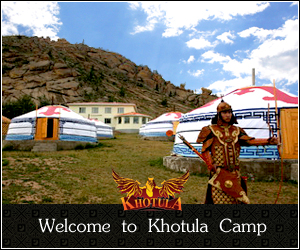Assembling Ger-Yurt
It is important to select a good site that has good, dry soil. The surface of the ground must be even. Before the floor is laid the soil must be shoveled in order to loosen and even it out. Mongolians always put up their yurts with the door facing south. By doing this they can use the roof ring, along with the sun to effectively tell time.
Putting in the Floor (Shal)
Historically, yurts didnŌĆÖt have floors and the nomads used to put up their yurts directly on the soil. One reason for this was that the herder families needed to bring there animals into their yurts during harsh weather so their animals were not harmed. The yurts were then sealed around the bottom edges with animal dung. Because of this, the inside of the yurt was warm even during cold season. Due to such peculiarities the yurtŌĆÖs basement or ŌĆ£buuriŌĆØ originated. Upon social development and changes in peopleŌĆÖs lifestyle, the yurts started having floors. The floors are usually made of wood. The size of a floor is longer than side-walls of a yurt by 20-30 cm. The middle part of the floor on the side of the door is longer than the other parts of the floor by 30-50cm. This extra space is used to form stairs. After the floor is laid the door is placed facing south and the walls are connected to the door. During the warm season the floor is put some distance from the ground, which keeps the yurt cool, and for the cold weather the floor must be low to the ground. Often times in the summer Mongolians will build their yurt with no floor at all. Also, when it is warm, the side-walls are lifted up to allow a draft to flow through.
Erecting the Walls (Khana)
Before circling the walls the roof ring, pillars, stove and other big items should be brought inside along with any furniture because after the walls are in place it is very difficult to move large items inside. It is traditional to begin erecting the walls on the side of the khatavch. The first wall is secured to the door and the other walls secured to this one. Where the walls meet the lattice work must be arranged so it is consistent and interlocking. The two ends of each wall are joined and then tied secure with ropes. After putting up all the walls, adjustments may be needed in order to get a proper shape. It is important to note that the height of the walls must match the height of the door. After the walls are up they must be secured with a strap (khoshlon) which is wrapped around the lattice and pulled tight.
Putting up the Roof Ring (Toono)
Before putting up the roof ring, the pillars must be fastened to the ring with string. Fastening ropes are placed in four parts of roof ring. They are used for centralizing and straightening the ring, also for joining ring, roof poles and the walls. At this point it may be necessary for a person to hold up the pillars while the roof poles are laid as it will be quite unstable.
Hanging the Roof Poles (Uni)
Hoops of the uni must be hung on inner side of the walls tops. This is good for holding uni from widening and pressure, from breaking of the binders. One or two persons should be propping the toono. Meanwhile, poles should be hung. At first, a few poles should be hung from all sides so that the toono will not be needful to be propped. The declination of the toono is adjusted with twis propes, and it is fixed stable by tightening and loosening from all parts of the wall. Finally, the twist ropes are tied tightly. Inside part of the walls tops are blue. Uni without hoops must be put on hollows on the door. Some producers mark on uni. Something heavy must be hung from pivot rope of toono. This provides support for preventing the movement of wooden parts of the ger.
Laying the Felt Cover and the Roof
The roof (deever) and outer felt covering (urkh) should be placed layer by layer and secured with rope. Up to three layers should be used depending on the season and temperature.
Covering with Outer White Cover
The outer white cover is shaped so that there are openings where the door and roof will be. The white cover must be arranged so that these are in the appropriate places and then stretched over the entire yurt so that there are not any creases visible. Recently white cover has been produced by water proof materials.
Drawing Outer Straps (Khoshlon)
The outer straps (khoshlon) are then drawn around the entire yurt and tightened very tightly to secure the entire yurt. Two or three straps should be used at different heights in order to provide an equally distributed stability.
Putting Up a Yurt (Ger)
Preparing for putting up a ger. To select the site and soil, to mark the place to build a ger, and put the basement of the ger. Mongolians have led nomadic lifestyle since ancient times. They have precisely identified the characters of landscape, which possess peculiar natural circumstances with combination of Khangai and Gobi, and diverse climate changes, and have developed different lifestyles suited to their living environment. Mongolia has four seasons and Mongolian herders constantly move following pastures. Mongolian ger is a dwelling perfectly suited to this way of life. A household moves into a new place and puts up the ger at the foreordained spot. Marking the spot and defining the point of putting up a ger is called laying a landmark. When choosing a spot to put up a ger, the pasture of livestock, water sufficiency and wind flow are considered first. In warm seasons, a household moves closer to the river and water, but when the cold season comes, they prefer the downhill. There are plenty places in the countryside with healthy even soil suitable for putting up a ger. But when putting up a ger in an urban area, the environment should be prepared before hand.












